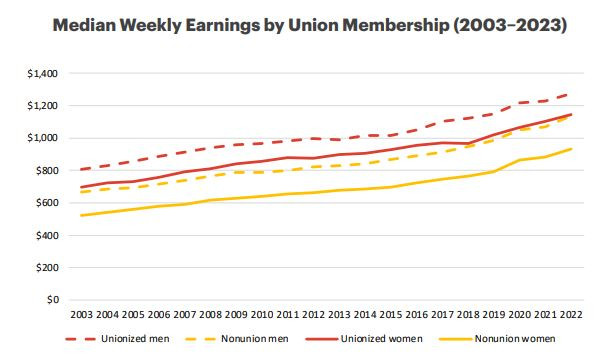
Latinas are the lowest paid demographic in the United States, one of the reasons union membership among them is increasing, bucking the national downward trend of at least four decades, according to a report released this week by the National Women's Law Center (NWLC).
The document, a fact sheet on union membership analyzing relevant trends among workers from all demographics in the United States, highlights that through 2023 women made up almost half of union members (45.6%).
Union membership for women has declined since data was first made available in 1983, but current trends indicate a potential increase in women's union membership in the future, the study says.
While union membership for women overall decreased from 9.6% to 9.5% between 2022 and 2023, union membership among Black women rose slightly from 10.3% to 10.5% and for Latinas from 8.5% to 8.8%, as per NWLC's calculations.
At the same time, union membership for White women decreased from 9.5% to 9.3% and for Asian women decreased from 9.1% to 7.8%, the report adds.
"Women who are union members experience more economic security for themselves and their families than nonunion members, including higher and more equal wages. For women of color, who face even more significant pay gaps and discrimination at work, union membership provides particularly meaningful wage improvements", the report says.
"Union members also have greater access to benefits—such as paid leave and sick days, predictable schedules, affordable health insurance, and retirement benefits— and the right not to be fired without cause."
Latinas' Earnings Compared to White Men
Nearly two-thirds of the lowest-paying jobs in the workforce are occupied by women, with Latinas, Native American and Black women, overrepresented in those positions.
The NWLC compared their average salaries with those of White men to measure the size of this gap and the difference that union membership can make in earnings.
The results show that "while union membership raises wages for all workers, women who are union members tend to experience larger wage gains than men."

Unionized women who worked full time were typically paid $1,174 per week—19% (or $191) more than women who are not in a union. In contrast, unionized men who worked full time were typically paid $1,341 per week— 14% (or $161) more than men workers who are not in a union.
Among full-time workers, unionized Latinas were typically paid 34% (or $265) more per week than Latina nonunion workers.
This is how much women earn for every dollar paid to a White man in the U.S. on average:
- Unionized women overall were typically paid 88 cents for every dollar unionized men were paid, while nonunion women were typically paid just 83 cents for every dollar nonunion men were paid.
- Unionized Latinas were typically paid 76 cents for every dollar unionized White men were paid, while nonunion Latinas were typically paid just 64 cents for every dollar nonunion White men were paid.
- Unionized Black women were typically paid 77 cents for every dollar unionized White men were paid, while Black women not in unions were typically paid just 72 cents for every dollar nonunion White men were paid.
- While unionized Asian women were typically paid $1.01 for every dollar unionized White men were paid, and Asian women not in unions were typically paid 1.07 cents for every dollar nonunion White men were paid.
- Unionized White women were typically paid 88 cents for every dollar unionized white men were paid, while nonunion White women were typically paid just 83 cents for every dollar nonunion White men were paid.
© 2025 Latin Times. All rights reserved. Do not reproduce without permission.





